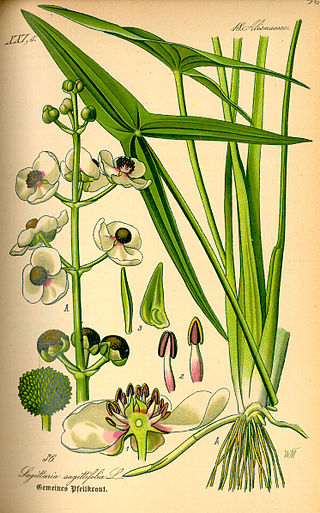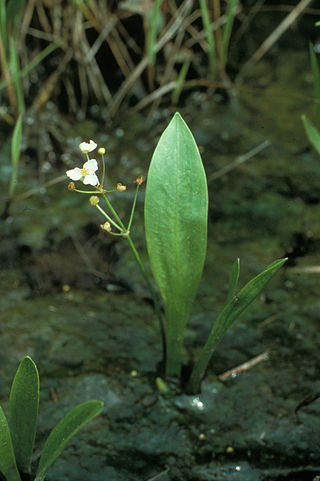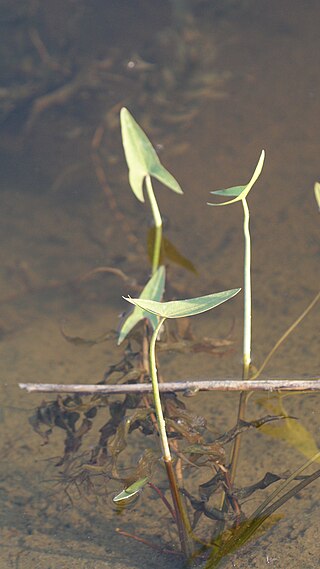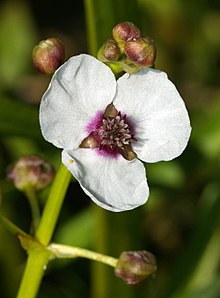
Sagittaria is a genus of about 30 species of aquatic plants whose members go by a variety of common names, including arrowhead, Katniss, duck potato, swamp potato, tule potato, and wapato. Most are native to South, Central, and North America, but there are also some from Europe, Africa, and Asia.

Kuwai is a Japanese plant whose underground stem (rhizome) is edible. It is a cultivar of Sagittaria trifolia. It has different common names in different regions of Japan. The underground stems of this neighboring species are also eaten in China.

Sagittaria latifolia is a plant found in shallow wetlands and is sometimes known as broadleaf arrowhead, duck-potato, Indian potato, or wapato. This plant produces edible tubers that have traditionally been extensively used by Native Americans.

Hemerocallis fulva, the orange day-lily, tawny daylily, corn lily, tiger daylily, fulvous daylily, ditch lily or Fourth of July lily, is a species of daylily native to Asia. It is very widely grown as an ornamental plant in temperate climates for its showy flowers and ease of cultivation. It is not a true lily in the genus Lilium, but gets its common name from the superficial similarity of its flowers to Lilium and from the fact that each flower lasts only one day.

Sagittaria fasciculata, the bunched arrowhead is a plant found in a small number of wetlands in the Southeast United States.

Sagittaria montevidensis is a species of flowering plant in the water-plantain family Alismataceae. Common names include giant arrowhead and California arrowhead.

Sagittaria cuneata is a North American species of flowering plant in the water plantain family known by the common name arumleaf arrowhead or duck potato. Like some other Sagittaria species, it may be called wapato.

Sagittaria longiloba is a North American species of flowering plant in the water plantain family known by the common name longbarb arrowhead and Gregg arrowhead.

Sagittaria sanfordii is an uncommon species of flowering plant in the water plantain family known by the common names valley arrowhead and Sanford's arrowhead that is endemic to California.

Sagittaria australis, the Appalachian arrowhead or longbeak arrowhead, is a plant found in North America. It is a perennial herb up to 130 centimetres tall. It is an unusual Sagittaria species in that it has a 5-winged petiole. The flowers are up to 3 cm (1 in) in diameter, white, producing an achene with a recurved beak.

Sagittaria platyphylla, the delta arrowhead, broad-leaf arrowhead or delta duck-potato, is a plant species native to the eastern United States.

Sagittaria trifolia, the threeleaf arrowhead or Chinese arrowhead, is a plant species widespread across the wet areas in Europe and in much of Asia.

Sagittaria rigida, the sessilefruit arrowhead or Canadian arrowhead, is an aquatic plant species. It has narrow oval leaves rather than the iconic arrowhead shaped leaves of species like the Sagittaria latifolia. it has sessile female flowers, from whence its name comes. Its flowers are very similar to other plants in the Sagittaria family, with three white petals.

Sagittaria teres, the quill-leaved arrowhead or slender arrowhead, is an aquatic plant species in the genus Sagittaria. It is a perennial herb up to 80 centimetres tall. The leaves can grow both under and above the water. The flowers are white, up to 1.5 cm in diameter, borne in one or more whorls on a stalk rising above the leaves.

Sagittaria ambigua, the Kansas arrowhead, is an aquatic plant species native to North America. It is a perennial herb growing up to 90 centimetres tall. The leaves are broadly lanceolate, the blade up to 20 cm (8 in) long and 12 cm wide.

Sagittaria brevirostra, common name Midwestern arrowhead or shortbeak arrowhead, is an aquatic plant species native to North America. It is a perennial herb growing up to 70 centimetres tall, with arrow-shaped leaves and white flowers.

Sagittaria engelmanniana is a perennial aquatic plant growing up to 70 centimetres tall. The leaves are sagittate (arrow-shaped) with 3 very narrow lobes.

Sagittaria graminea, the grassy arrowhead or grass-leaved arrowhead, is an aquatic plant species native to eastern North America.

Sagittaria guayanensis, the Guyanese arrowhead, is a perennial aquatic plant species native to both the Old and New World. It has broadly hastate (arrow-shaped) leaves with ovate lobes.

Sagittaria subulata, the awl-leaf arrowhead, narrow-leaved arrowhead or dwarf sagittaria, is an aquatic plant species.






















